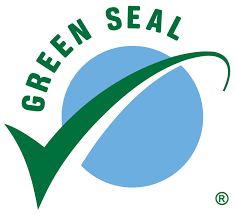

As businesses and schools consider COVID-19 disinfection regimens that expose building occupants to unnecessary health risks, Green Seal released in June Guidelines for Safer COVID-19 Cleaning and Disinfection that spell out effective and responsible cleaning practices for occupant health and safety during the pandemic.
These five best practices – intended for facility, property and housekeeping managers – are based on the latest scientific understanding of the COVID-19 virus and build on guidance from the Centers for Disease Control and Prevention and the Environmental Protection Agency. They also reflect Green Seal’s expertise in setting science-based standards for cleaning products, principles, and practices that deliver uncompromising performance while reducing use of hazardous chemicals and promoting safer and healthier indoor air.
Improper cleaning and disinfection practices – such as neglecting required product contact times, using inappropriate procedures or application methods, or failing to communicate with cleaning workers and building tenants – can expose building occupants to unsafe levels of hazardous chemicals while failing to protect them from COVID-19.
With actionable best practices and clear infographics, Green Seal’s Guidelines explain how to:
- Create a cleaning and disinfecting plan.
- Ensure that cleaning personnel are properly trained.
- Maintain sustainability and healthy indoor air.
- Communicate the cleaning and disinfecting plan.
- Provide safer working conditions.
Implementing the five best practices can contribute to earning the new LEED Pilot Credit – Safety First: Cleaning and Disinfecting Your Space”, promoting easy adoption by project managers seeking LEED® credit. The Guidelines also align with the requirements in the features related to cleaning products, practices, and protocols in WELL v2 and the recently announced WELL Health Safety Rating for Facilities Management and Operations.
Green Seal-certified cleaning services already are verified to meet strict third-party standards for safe and effective cleaning and disinfecting, including rigorous requirements for training and operations. The Guidelines provide these best-in-class cleaning services additional guidance for pandemic-specific practices.
“Effectively cleaning workplaces during the pandemic demands rigorous planning, training, and procedures – there are no shortcuts,” said Green Seal CEO Doug Gatlin. “Blanketing a building in hazardous chemicals won’t necessarily prevent the spread of COVID-19, but it will create significant health risks for those inside. These five best practices for safer COVID-19 cleaning and disinfection are a handbook for workplaces that are committed to comprehensively protecting the health of their building occupants during the pandemic.”
Health experts caution that repeated or extended exposures to disinfectant chemicals can lead to significant health effects — especially among those with asthma, allergies, migraines or suppressed immune systems. Some common disinfectant ingredients have been linked to reproductive toxicity and cancer.
The Guidelines caution against using application tools such as foggers that are being marketed for controlling COVID-19, but which unnecessarily increase hazardous chemical exposure while providing no added protection against the pathogen.
To learn more and download Green Seal’s Guidelines for Safer COVID-19 Cleaning and Disinfection, visit https://greenseal.org/disinfecting-guidelines.
